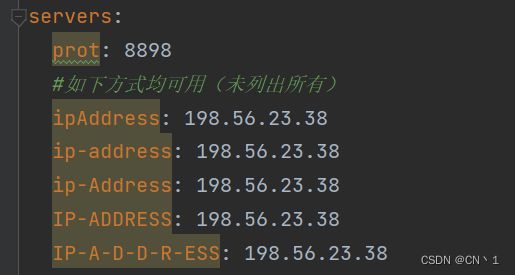SpringBoot-属性绑定和bean属性校验
目录
属性绑定
自定义类属性绑定
第三方bean属性匹配
规则:松散绑定(宽松绑定)
Bean属性校验
属性绑定
属性绑定:我们可以使用配置文件对类的属性进行赋值绑定。
自定义类属性绑定
我们自定义一个类,在此使用yml文件进行类属性的绑定。
属性绑定步骤:
1.创建一个类,设置字段。
public class ServiceConfig {
private int prot;
private String ipAddress;
private long timeOut;2.添加注解
@Component
@Data
@ConfigurationProperties(prefix = "servers")
public class ServiceConfig {
private int prot;
private String ipAddress;
private long timeOut;注解说明:
@Component:将此类加入Spring容器。
@Data:使用lombok快速创建实体类。
@ConfigurationProperties:声明此类使用配置文件进行属性绑定,
并且设置使用配置文件中的哪个数据。
3.配置文件设置数据
4.测试:在boot引导类中
@SpringBootApplication
public class SpringBootDemo2Application {
public static void main(String[] args) {
ConfigurableApplicationContext context = SpringApplication.run(SpringBootDemo2Application.class, args);
//获取自定义类
ServiceConfig bean = context.getBean(ServiceConfig.class);
//打印获取的bean,查看是否成功绑定属性
System.out.println(bean);
}
}测试结果: 发现打印出来的数据就是我们在yml中设置的数据
第三方bean属性匹配
说明:有时候我们的需求并不只是想要给我们自己的类进行属性绑定,还需要给第三方的bean进行属性绑定。
在此使用DruidDataSource作为第三方bean,为此bean进行属性绑定。
将Druid加入spring容器。(操作前提是导入了Druid坐标)
@Bean
@ConfigurationProperties(prefix = "datasource")
public DruidDataSource dataSource(){
DruidDataSource druid = new DruidDataSource();
return druid;
}yml文件中进行属性绑定
datasource:
username: root
password: root
driverClassName: com.mysql.cj.jdbc.Driver
url: jdbc:mysql://localhost:3306/test测试:打印第三方bean的配置数据到控制台看效果
@SpringBootApplication
public class SpringBootDemo2Application {
@Bean
@ConfigurationProperties(prefix = "datasource")
public DruidDataSource dataSource(){
DruidDataSource druid = new DruidDataSource();
return druid;
}
public static void main(String[] args) {
ConfigurableApplicationContext context = SpringApplication.run(SpringBootDemo2Application.class, args);
DruidDataSource bean = context.getBean(DruidDataSource.class);
System.out.println(bean.getUsername());
System.out.println(bean.getPassword());
System.out.println(bean.getUrl());
System.out.println(bean.getDriverClassName());
}
}测试结果:
规则:松散绑定(宽松绑定)
宽松绑定是一种特性,说的是在配置文件中的绑定属性的数据时,属性名的书写规定很宽松。
松散绑定的规则:忽略标点符号,将所有字母转为小写
特点:匹配规则很宽松。
举例:属性绑定,在配置文件中设置多种属性名进行匹配。
我们配置类的ipAddress属性,查看在配置文件中书写属性的多种形式。
需要设置的属性:
配置文件中进行属性绑定:
说明:上面的方式,均可以对属性进行绑定,并未列出所有。
原因:忽略标点符号,将所有字母转为小写
如上方式有很多种,其中,官方主张”烤肉串模式”。
烤肉串模式:ip-address: 198.56.23.38
值得注意的是:
如上的宽松绑定规则仅仅限于:@ConfigurationProperties
Bean属性校验
对类的属性赋值时自定义规则进行校验。
"属性校验"使用步骤
1.导入对应坐标
javax.validation
validation-api
org.hibernate.validator
hibernate-validator
坐标说明:
validation-api:是属性校验的接口坐标。
hibernate-validator:相当于是属性校验的接口实现类坐标。
两者关系就像jdbc和MySQL驱动相似,所以需要导入两个坐标。
2.开启校验功能
在需要启用校验功能的类上写注解:@Validated。
@Data
@ConfigurationProperties(prefix = "servers")
@Validated
public class ServiceConfig {
}3.设置校验规则
在属性上设置校验规则
@Data
@ConfigurationProperties(prefix = "servers")
@Validated
public class ServiceConfig {
@Max(value = 8888,message = "最大值能超过8888")
@Min(value = 200,message = "最小值不可小于200")
private int prot;
private String ipAddress;
private long timeOut;
}说明:如上代码中,@Max和@Min就是设置的规则,其中有value和messge两个属性。
提供数据校验的规则有许多,如下(查看constraints包):
4.测试
我们使用yml文件进行属性绑定,进行属性校验,如果不符合条件则报错。






